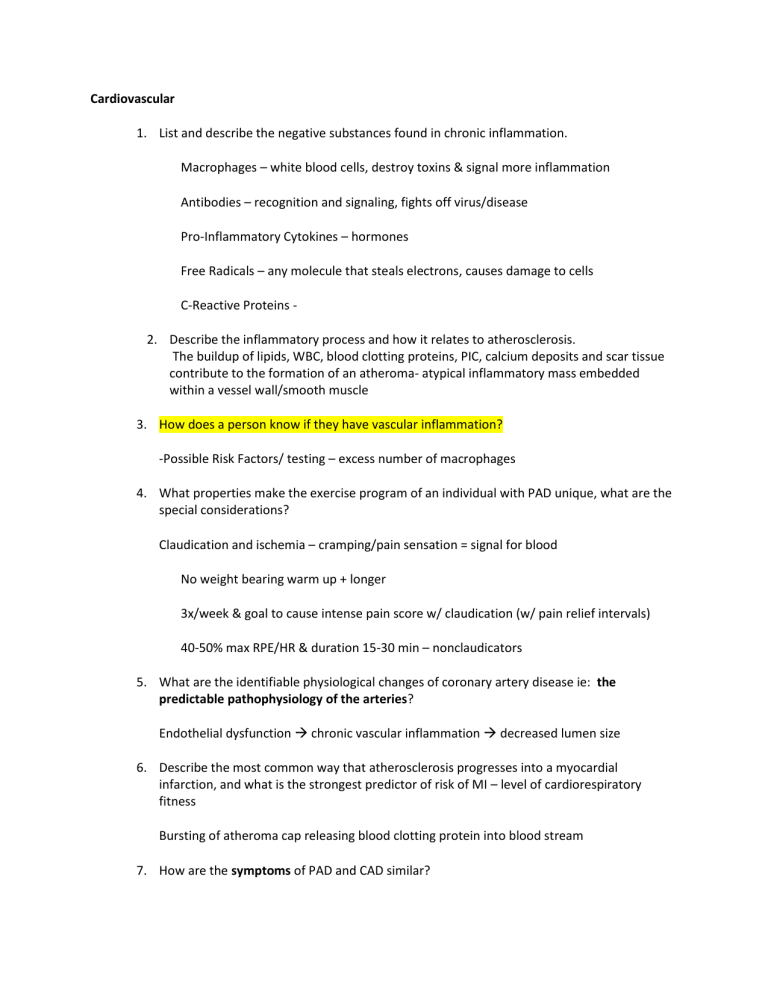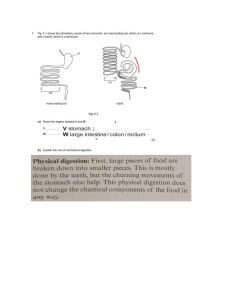
Cardiovascular 1. List and describe the negative substances found in chronic inflammation. Macrophages – white blood cells, destroy toxins & signal more inflammation Antibodies – recognition and signaling, fights off virus/disease Pro-Inflammatory Cytokines – hormones Free Radicals – any molecule that steals electrons, causes damage to cells C-Reactive Proteins 2. Describe the inflammatory process and how it relates to atherosclerosis. The buildup of lipids, WBC, blood clotting proteins, PIC, calcium deposits and scar tissue contribute to the formation of an atheroma- atypical inflammatory mass embedded within a vessel wall/smooth muscle 3. How does a person know if they have vascular inflammation? -Possible Risk Factors/ testing – excess number of macrophages 4. What properties make the exercise program of an individual with PAD unique, what are the special considerations? Claudication and ischemia – cramping/pain sensation = signal for blood No weight bearing warm up + longer 3x/week & goal to cause intense pain score w/ claudication (w/ pain relief intervals) 40-50% max RPE/HR & duration 15-30 min – nonclaudicators 5. What are the identifiable physiological changes of coronary artery disease ie: the predictable pathophysiology of the arteries? Endothelial dysfunction chronic vascular inflammation decreased lumen size 6. Describe the most common way that atherosclerosis progresses into a myocardial infarction, and what is the strongest predictor of risk of MI – level of cardiorespiratory fitness Bursting of atheroma cap releasing blood clotting protein into blood stream 7. How are the symptoms of PAD and CAD similar? Both set of symptoms are brought on by ischemic 8. What are the special considerations in an individual with vascular diseases such as hypertension, CAD/PAD? Watch for hypotension (body position & work up gradually) & blood pressure 9. What are the effects that exercise can have on the body after a myocardial infarction? Increase VO2 max, decreased angina pectoris, Increase in ANS balance, Thicker endothelial cap over atheromas, Increase in HDL and decrease in LDL, Decrease in systemic inflammation 10. What are the effects that exercise can have on a body that has HTN? Increases in vasodilation and autonomic tone 11. What are the rules for knowing if exercise is safe for an individual with HTN? Stop exercise/testing if either systolic OR diastolic reaches: – Resting BP • systolic over__200___ • diastolic over_110___ – Exercise BP • systolic over_250___ • diastolic over__110__ • Decrease intensity, but exercise if: 180/110 ADDITIONAL PROVIDER CLEARNANCE NEEDED 12. How do you coach proper lifting technique to avoid Valsalva and prolonged isometrics? Avoid heavy lifting and teach breathing in on eccentric (low the weight) and out on concentric (lift/push the weight) 13. Mr. Rogalski had the following blood tests at his last physical. How do his numbers compare to the laboratory numbers known to be risk factors for CAD HDL: 27 LDL: 154 Triglycerides: 210 Total cholesterol: 223 What number/s needs to be increased? HDL needs to be increased. What number/s need to be lowered? Why are high numbers unhealthy? LDL, Total cholesterol and Triglycerides need to be lowered; these numbers are unhealthy because they are too high. High numbers mean more fat within the blood stream contributing to size atheroma’s Pulmonary 1. What are the signs and symptoms that you know to be true if a condition is within the category of COPD diseases? Hyperpnea – Dyspnea – breathlessness Tachypnea - >20 breathes a minute 2. What are the characteristics that are UNIQUE to emphysema? Definition: Cackling during breathing Barrel chested – overuse muscles during breathing (expiration & dead space) 3. What are the characteristics that are UNIQUE to chronic bronchitis? Pale in color from hypoxia (not enough oxygen) Fluid retention (puffy/bloated) Wheezing – rattling mucus sounds with expiration – chronic cough with mucus 4. What are the special consideration/adaptations necessary for a person with respiratory dysfunction during exercise? Orthostatic – body positioning (limiting up to down movement & vice versa BODI index – BMI (above 21), Obstruction of airflow, dyspnea & exercise capacity 5. What is the true definition of exercise induced asthma? Explain the physiology as to why exercise causes asthma? How do you avoid triggering that physiological response? Brought on by physical activity after 10-15 (hormone triggered to increase tidal volume) Exercise autonomic 6. What facts would you use to convince someone that exercise is important with respiratory dysfunction? Ie: what are the possible positive effects of exercise on a body with respiratory dysfunction. Improves ventilatory efficiency – more efficient gas exchange & reduces hyperinflation Desensitized to dyspnea – perception & actual physiological Decreased in total inflammation 7. Why is exercise a fundamental aspect within the prognosis of respiratory conditions? (Be sure to include the prognosis prediction equation in your answer.) Decreases inflammation and improves ventilatory/ventilation exchange. Less load/stress on the body Physical activity level is best predictor of all-cause mortality with 4-year survival 8. What is a specific movement/position limitation for individuals where emphysema is dominating? Explain to your client what it is about their condition (anatomy/physiology/biomechanics) that causes this limitation. Overhead/90 arm movements – limits ROM, due to use of neck, shoulders and intercostals, of breathing which decreases amount of oxygen that can be taken in 9. What is a specific movement/position limitation for individuals where chronic bronchitis is dominating? Explain to your client what it is about their condition (anatomy/physiology/biomechanics) that causes this limitation. Limit exercises on back – Due to gravity not being able to assist with breathing and the mucus that has been built up is just sitting in the airway/bronchioles 10. You have a client with exercise induced asthma and no history of success with exercise. Explain all factors you would control, change, adopt to be sure that they experienced success when completing exercise sessions with you. Long warm up and cool down – don’t shock, avoid quick changes in tidal volume, Breath through nose – humidifies air before enters lung, respond best to exercise in mid-late morning, avoid extremes in temp and humidity, Anxiety, depression, and fear are common due to dyspnea and physical disability 11. You have a client who is feeling a little uncomfortable during exercise and is scared he is having acute bronchospasms (attack). You have him take a peak flow reading, which is 440 L/min. His normal PEF at rest is 520 L/min. Do these numbers indicate a need to change the activities within the current exercise session? Why or why not? No, no change in activities is needed. Client is still above 80% PEF, maybe decrease intensity due to comfortability and continue to monitor 12. What other special considerations should we be aware of, both to focus on improving their outcomes, or keeping the individual safe? Knowing where rescue inhalers are located & emergency/complete plan of action, individual triggers, knowing clients medications Diabetes 1. What are the pre-exercise glucose guidelines for an individual with diabetes, and why are these rules important? – so that they client does not go hypoglycemic Test glucose 15 minutes before exercise Glucose less than 100mg/dL – consume 15-40 g Carbs, recheck after 15 minutes – if over 100mg/dL can start exercise Glucose over 250mg/dL – test ketones in urine Over 250mg/dL with ketone – DO NOT EXERCISE Glucose over 250-300mg/dL without ketones – exercise is okay, decrease intensity/duration & be caution/monitor 2. Describe how glucose goes from the bloodstream to the muscle cells. How does exercise affect this process? GLUT 1 gate – always open GLUT 4 gate – always closed unless opened by insulin & can be opened during exercise without insulin Why do cells starve despite high glucose in blood? – lack of GLUT4 gate being insulin resistant or deprived 3. What are the etiologies of type 1 and type 2 diabetes? Type 1 (insulin dependent) - diagnosed most often in children and young adults, considered to be an autoimmune pathway, physiological damage: beta cells destroyed by own antibodies and inflammatory respone. IDIOPATHIC Type 2 (insulin resistance) – prevalent in middle ages and older adults: BMI obese or higher, 65 and older, physically inactivity, stringer genetic-ethnic link. IDIOPATHIC 4. Describe the glycation process, including laboratory testing for it, and what its effects on the pathophysiology of diabetes are. Glycation – accidental binding of glucose lipid or protein (does not take any energy, happens by chance) HbA1c – concentration of hemoglobin molecules that have glycated with a glucose molecule Glycations effects of pathophysiology of diabetes are advanced glycated end products (AGEs) – produced free radicals which damage cellular structure and cause inflammation 5. What are the symptoms of hypoglycemia? What do you do if this occurs during exercise? Overall, just don’t fell right; Feeling shaky/jittery, Nervous/anxious/sweating, Sleepy/fatigue/confusion, Blurred vision, Headaches, decreased coordination, Emotional switches, Tachycardia, Hunger/nausea, Tingling in face/lips/tongue Ingest 15-40 grams simple carbs, recheck blood glucose after 15 minutes – repeat if still hypo 6. What are the special considerations and contraindications of exercise with diabetes? Repeat for many sessions until glucose levels are predictable Contradictions – be aware of hypoglycemia (lack of glucose control or taking too much medication) blood glucose levels >250mg/dL and <100mg/dL 7. What are the rules for blood glucose testing during an exercise program with an individual with diabetes? Gradual progression, test before during and after, repeat for as many sessions as necessary until glucose levels are predictable If dropped during exercise – 15-40g Carbs, retest after 15 minutes and repeat if needed 8. What are the rules for cardiovascular clearance to participate in exercise with diabetes? Addition clearance if – over 35yrs old, had type 2 for greater than 10yrs, type 1 for more than 15yrs or type 2 diabetes taking insulin 9. Why is footwear a concern with diabetes? Describe IN DETAIL the two major changes (pathophysiology) that cause the concern. Circulation issues – blood glucose glycates with endothelial lining of vessels endothelial layer loses normal function, becomes scarred, weak and chronically inflamed inflamed small vessels crack, then leak, slowing the blood flow beyond leak tissue supplied by these small vessels becomes ischemic, eventually die off in addition, this reaction causes free radicals /pro-inflammatory cytokines which increase chronic inflammation, leading to more vessel damage Neurological issues – nerve becomes ischemia (from capillary damage) myelin sheath of free nerve endings susceptible to free radical damage from advanced glycated end products Feet common – length dependent – pathophysiology: starts at the ends of nerves in the body = feet are the furthest away from heart, more likely to develop first and worsen fastest


